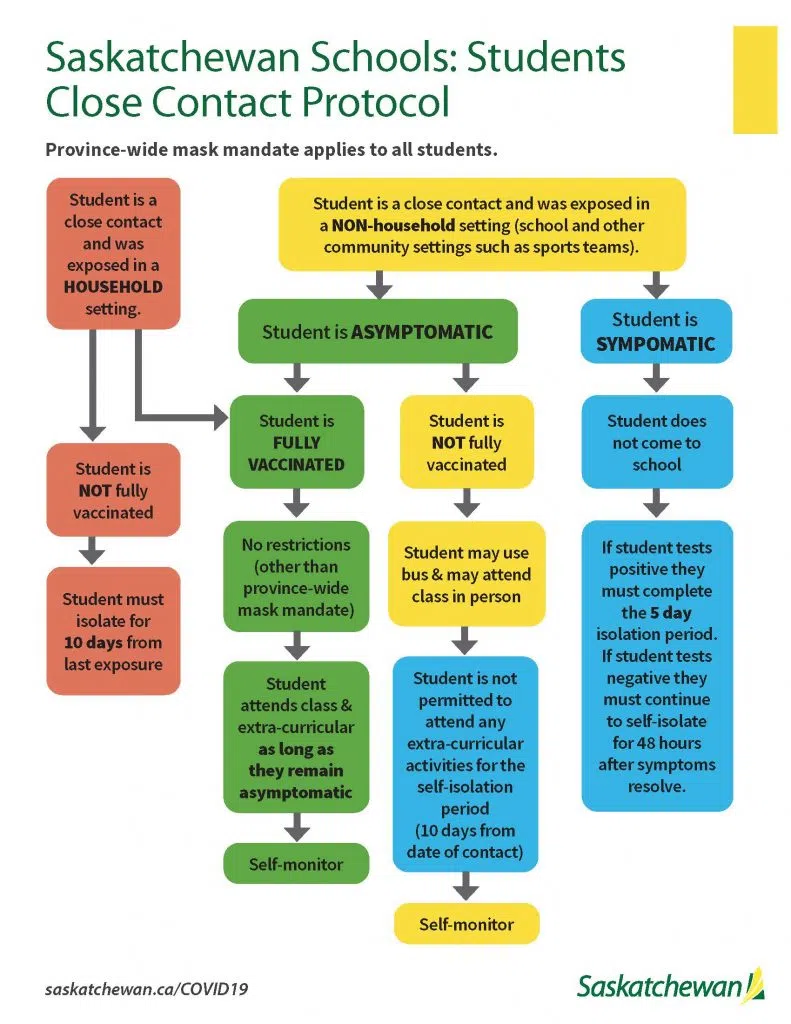The Saskatchewan government doesn’t have any immediate plans to move schools to online learning.
On Wednesday, the government outlined the steps it plans to take to keep schools operating in the midst of a fifth wave of COVID-19.
While other provinces have pushed back the start dates for schools as Omicron cases mount, Saskatchewan has opted to forge ahead. Kids went back to school as scheduled this week.
Education Minister Dustin Duncan defended that decision, telling reporters the high number of rapid tests in Saskatchewan and the relatively low number of hospitalizations in the province were signs that students could return to class.
“Moving to extended absences or remote learning, an extended period of time away from our students’ social networks, that is not consequence-free,” Duncan said during a media conference.
“We have worked very closely with our school divisions and with the (Saskatchewan School Boards Association) and from that group, there was certainly no interest that was expressed to extend the holiday break, whether that be two days or a week.”
The Saskatchewan Teachers’ Federation had requested the return to class be delayed for two days to address cohorting and staff shortages, but Duncan said that, after speaking with divisions and their administrators, the two days wouldn’t have provided any value.
Duncan admitted there will be high case counts in the coming days and weeks and that may require some students to learn online. However, he said the province didn’t see the need to start 188,000 students learning from home right after the Christmas break.
“We have had disruptions in the past as well in previous waves and we have always worked very hard to try to ensure as much in-class learning as possible,” Duncan said.
“We felt like, because of a number of factors, that we were in a good position to start after the holidays and obviously we’ll pivot where we need to depending on what case numbers do but also what we see in terms of pressures on human resources (and) on kids’ availability to be in the classroom.”
Duncan explained that divisions have a layered approach and are doing what they can to mitigate the risk of transmission as much as possible.
“But we also want to mitigate against the consequences of having students out of schools and outside of classrooms, not in front of a teacher for an extended period of time,” Duncan said.
On Wednesday, Duncan announced some changes to isolation rules around close contacts.
Positive test results for staff or students have to be reported to the school office, which then will notify parents and guardians or those on buses about the cases.
“Fully vaccinated students and staff who are close contacts will follow the current process of self-monitoring,” the government said in a media release. “They are able to attend school and other activities as long as they remain asymptomatic. Fully vaccinated students and staff who test positive are required to self-isolate for five days.”
Close contacts in settings like schools, daycares or recreation activities who aren’t fully vaccinated can attend school or child-care facilities as long as they’re asymptomatic, but they can’t take part in extracurricular activities for the 10 days of their self-monitoring period.
If the transmission was in a household setting, unvaccinated students must isolate for 10 days and can’t attend school or child care.
Unvaccinated staff members who are a close contact have to self-isolate for 10 days following their last exposure to the positive case.
“In the case of an outbreak in a school, which is defined as three or more cases in a class or cohort of students, public health will continue to investigate and may advise further mitigation measures for either the class or the entire school,” the government said.
The province said an increase in cases in the community will mean an increase in cases in schools, so it once again urged people to get vaccinated, to get their booster shots when they’re eligible, to wear masks, to use rapid tests and to stay home when they’re sick.
The government noted more than 1.6 million rapid antigen tests have been given to families through the province’s elementary schools, and rapid tests also will be available in high schools. Another 250,000 rapid tests are to be made available in the province.
“We know that as COVID case numbers increase in the community, and as Omicron becomes the dominant variant in Saskatchewan, we are going to see increased cases in schools. That is our reality,” Duncan said.
NDP response
In an emailed statement, NDP Education Critic Carla Beck slammed the government’s plan, saying: “There was no plan at all.”
“Everyone agrees that it is in the best interest of students to have them in school,” Beck wrote. “However, a ‘wait and see’ strategy that risks their safety will not accomplish that.
“If you know a hurricane is coming, you don’t wait for the storm to hit to board up your windows. The longer you wait and sit on your hands, the fewer options you leave for school divisions and parents, eventually forcing classes online when you no longer have the staffing capacity in schools.”
Beck said the response was “too little, too late,” noting Duncan made no mention of increased staffing, additional personal protection equipment, ventilation upgrades or measures that are being applied in other provinces.











